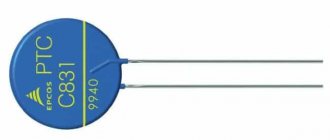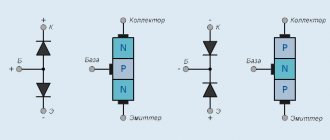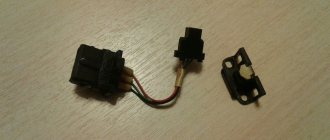Good day to all! Today I’ll tell you how to check a Hall sensor, what methods exist for assessing the condition of a device, and what you should pay attention to.
Motorists and those who ride a scooter and have a contactless ignition system or electronic ignition in their vehicle design have probably heard about this sensor or controller. It is also often called the camshaft position sensor or simply the camshaft position sensor.
The device is even found on phones. But since we have an automotive website, we will talk about the Hall sensor specifically in relation to cars and vehicles.
Before touching on the topic of verification methods, it would not be amiss to understand the very essence of the device in question, its functions and operating principle.
What is a Hall sensor
Hall sensors are solid-state radio elements that are becoming increasingly popular in the amateur radio environment and the development of radio-electronic devices.
They are used in sensors for measuring position, speed or directional movement. They are increasingly replacing limit switches and reed switches. Since such sensors are completely sealed and are a simple radio element, they are not afraid of vibration, dust and moisture. That is, in essence, a Hall sensor, in simple words, is a radio element that responds to an external magnetic field. Interestingly, many modern smartphones have a Hall sensor (albeit a simplified version). It can detect the presence of a magnetic field and works together with a magnetic sensor, which is responsible for the compass. The Hall sensor is also used in phones for which special cases with a magnetic clasp are available - Smart Case. The sensor detects whether the case cover is open or closed and automatically turns the display on/off. To find out what sensors your smartphone has, use these instructions.
The role of the sensor in the SZ system
ATTENTION! A completely simple way to reduce fuel consumption has been found! Don't believe me? An auto mechanic with 15 years of experience also didn’t believe it until he tried it. And now he saves 35,000 rubles a year on gasoline! Read more"
If the sensor or DC malfunctions, problems arise related to the direct functioning of the engine. The car may not start at all or behave extremely poorly on the road. Is it really possible for such a small element as DH to have such a powerful effect on a car’s engine? Yes, yes.
What is DH? This is a controller capable of sensitively responding to any changes in the magnetic field. If the DC is faulty, the injector stops functioning.
The interaction of the DC with the ignition system in the electrical sense is carried out through a switch or conductor. As a result, a magnetic field appears.
Hall effect
This was back in the 19th century. American physicist Edwin Hall discovered a very strange effect. He took a plate of gold and began to pass direct current through it. In the picture I marked this plate with faces ABCD.
He passed a direct current through faces D and B. Then he brought a permanent magnet perpendicular to the plate and discovered a voltage on faces A and C! This effect was named after this great scientist. The basic physical principle of this effect was based on the Lorentz force. Therefore, radioelements based on the Hall effect began to be called Hall sensors.
But there is one small nuance here. The fact is that the Hall voltage, even at the highest magnetic field strength, will be some microvolts. Agree, this is very little. Therefore, in addition to the plate itself, DC amplifiers, switching logic circuits, a voltage regulator, and a Schmitt trigger are installed in the Hall sensor. In the simplest switching Hall sensor it all looks something like this:
Where
Supply Voltage - sensor supply voltage
Ground - earth
Voltage Regulator - voltage regulator
A - operational amplifier
Hall Sensor - actually the Hall record itself
Output transisitor Switch - output switching transistor (transistor switch)
Linear (analog) Hall sensors
In linear sensors, the Hall voltage (voltage on edges A and C) will depend on the magnetic field strength. Or in simple words, the closer we bring the magnet to the sensor, the greater the Hall voltage will be. This is a linear relationship.
In linear Hall sensors, the output voltage is taken directly from the operational amplifier. That is, in linear sensors you will not see a Schmitt trigger, nor an output switching transistor. That is, it will all look something like this:
What does the voltage on faces A and C depend on? Mainly from a magnetic field created by either a permanent magnet or an electromagnet; the thickness of the plate, as well as the strength of the current flowing through the plate itself.
Theoretically, if a very strong magnetic flux is applied to the Hall sensor, then the Hall voltage will be infinitely large? No matter how it is). The output voltage will be limited by the supply voltage. That is, the graph will look something like this:
As you can see, up to a certain point we have a linear dependence of the sensor output voltage on the magnetic flux density. Further increase in the magnetic flux is useless, since it has reached the saturation voltage, which is limited by the supply voltage of the Hall sensor itself.
Thanks to these parameters, using a Hall sensor, devices were built that made it possible to measure the current strength in a conductor without touching the wire itself, for example, current clamps.
There are also instruments that can be used to measure the magnetic field strength. Hall sensors used in these devices are called linear , since the voltage across the Hall sensor is directly proportional to the magnetic flux density.
Linear sensors, as I already said, can be used in current clamps. They allow you to measure current ranging from 250 mA to several thousand Amperes. The biggest advantage in such current clamps is the absence of mechanical contact with the measured circuit. In other words, Hall effect current meters are much safer than shunt and ammeter based meters, especially when the circuit current is high, which is often found in industrial installations.
Example of using an analog element
Let us consider, as an example, the design of a current sensor whose operation is based on the Hall effect.
Simplified circuit of a current sensor based on the Hall effect
Designations:
- A is a conductor.
- B – open magnetic conductor ring.
- C – analog Hall sensor.
- D – signal amplifier.
The operating principle of such a device is quite simple: the current passing through the conductor creates an electromagnetic field, the sensor measures its magnitude and polarity and produces a proportional voltage UDT, which is supplied to the amplifier and then to the indicator. https://www.youtube.com/watch?v=fmLs9WsKx3I
Digital Hall sensors
As soon as the era of digital electronics arrived, various logic elements began to be placed in one housing along with a Hall sensor. We have already reviewed the simplest Hall sensor on a Schmitt trigger above and it looks like this:
In fact, such a sensor has only two output states. Either the signal is present (logical one) or it is not (logical zero). The hysteresis on the Schmitt trigger simply eliminates frequent switching, which is why it is always used in digital Hall sensors.
As a result, the industry began to produce Hall sensors for digital electronics. Basically, such sensors are divided into three types:
Unipolar
They react only to one magnetic pole. No attention is paid to the opposite magnetic pole. For example, we bring the south pole of the magnet and the sensor will work. It will not react to the north magnetic pole.
Bipolar
We bring the magnet to one pole - the sensor will work and will continue to work even when we remove the magnet from the sensor. In order to turn it off, we need to apply a different magnet polarity to it.
Verification methods
You can use several diagnostic methods for the sensor located on the distributor.
Depending on the available means and capabilities, the motorist can check the current condition of the Hall controller with his own hands, evaluate its performance and make the appropriate decision on replacement.
As soon as you notice one or more of the symptoms presented, you should get checked. You can do it in several ways. I propose to consider them separately.
Wedge with wedge
The simplest and most effective method that does not require you to equip yourself with a tester or multimeter. But you will need a known-good similar Hall sensor.
The essence of diagnosis is outrageously simple. You remove the old controller and install a new one in its place. If after the manipulation the symptoms go away and engine operation returns to normal, then simply leave the new part in place. If you borrowed a DH from a friend or neighbor in the garage, remove the device, say thank you, and go to the auto parts store.
Voltmeter and multimeter
Using a voltmeter or a classic tester, you can easily check the condition of the device.
I think every motorist can use the tester. The task is to measure the voltage at the sensor output.
If the DC is in good condition, the tester will produce values in the range of 0.4-11 V.
A universal multimeter is used in exactly the same way. You just need to select the voltmeter mode on it.
Sensor simulation
Quite an interesting and effective method. But here you will have to do a little work with your own hands.
The principle of imitation is as follows. First, remove the block from the DH, which has 3 plugs. Next, start the ignition on the car, then connect outputs 3 and 6 to each other.
If a spark appears during such manipulation, then most likely the DC has failed.
Without testers
When testers are not available, testing can be done using a slightly different method.
Here you need to carry out step-by-step manipulations:
- the spark plug is connected to the wire terminal from the coil;
- the threaded part of the spark plug is connected to the ground;
- the carriage with the sensor is dismantled;
- connector is connected;
- the ignition is turned on;
- a metal object is held near the sensor;
- When a spark appears on the spark plug, the DH is operational.
Just be extremely careful when doing such manipulations with your own hands.
Homemade tester
You can assemble an analogue of the tester from practically available materials.
The testing device consists of a regular LED, a 1 ohm resistance and two pieces of flexible wiring that need to be soldered to the leg.
How to check the Hall sensor
Let's look at the operation of the SS41 digital bipolar Hall sensor. Our client looks like this:
Judging by the datasheet, we supply plus power to the first leg, minus to the second, and from the third leg we remove the signal of a logical one or zero.
To do this, let's assemble a simple circuit: a 3-volt LED, a 1-kiloohm current-limiting resistor, and the Hall sensor itself.
Now we connect to our circuit from the power supply, setting it to 5 Volts. The minus is on the middle pin, and the power plus is on the first.
I had this magnet on hand:
To avoid mixing up the poles, I marked one of the magnet poles with a red paper price tag. Which one I don’t know, since I don’t have a compass with which I could find out where the north pole is and where the south pole is.
As soon as I brought the magnet with the “red” pole to the hall sensor, my LED immediately went out.
I turn the magnet over to the other pole, bring it to the Hall sensor and voila!
If the magnet is not turned over, that is, the poles are not changed, then the LED will also remain extinguished, because the sensor is bipolar.
By the way, read about the bipolar transistor.
And here is a video of the work
As you can see in the video, we use a magnet to control the Hall sensor. The Hall sensor gives us two signal states: there is a signal - one, no signal - zero. That is, the LED is on - one, the LED is off - zero.
How to find and order the necessary sensors on Aliexpress at a reasonable price and free shipping
- We register on the site, for which you need to enter your email address, last name and first name, and also create a password. After this, you must confirm your email address, otherwise your account will be blocked.
- Next you need to fill in the delivery address. This is done in your profile and always in Latin characters.
- On the left, next to the “Categories” column, click on the “See all” link.
- Select the “Cars and Motorcycles” category.
- Then click on the link “Car parts”.
- On the left side of the page, select the “Sensors” category.
- In the search line, enter the name of the required sensor, for example, a speed sensor.
- Check the box next to free shipping.
- We choose to sort the results by seller rating.
- We go to the product description page, where we select the quantity, size and color.
- Click on the “Buy Now” link.
- We make payment for the order.
Application of Hall sensors
Currently, the scope of application of Hall sensors is very extensive and is becoming wider and wider every year. Here are the main applications:
Application of linear sensors
- current sensors
- tachometers
- vibration sensors
- ferromagnetic detectors
- rotation angle sensors
- non-contact potentiometers
- brushless dc motors
- flow sensors
- position sensors
Application of digital sensors
- speed sensors
- synchronization devices
- car ignition system sensors
- position sensors
- pulse counters
- valve position sensors
- door lock
- flow meters
- contactless relays
- proximity detectors
- paper sensors (in printers)
Reasons for DH failure
The position sensor can be damaged by the following factors:
- serious overheating of the power unit (the temperature should exceed 150-180 degrees);
- power surges;
- penetration of moisture into the body of the electric motor or accelerator handle;
- mechanical damage.
A clear sign of a DH malfunction is twitching of the motor-wheel at start-up when the accelerator is applied. To diagnose such a failure, we only need a voltmeter.











